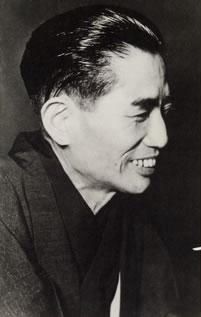I was excited to find this postage stamp celebrating the centennial of the birth of Miyagi Michio, a blind koto player from Japan. Musicians and composers are rare to find on stamps from Asia and Japan has not featured many music-themed stamps of any type. On top of this, I think this stamp has a very handsome design that features both the musician and references the instrument he was famous for playing.
Miyagi Michio
Miyagi Michio (1894-1956) was born in Kobe with a rare eye disease. After going completely blind at the eight of eight, he began an apprenticeship with the master koto player Nakajima Kengyō. At the age of thirteen, his family moved to Korea where Michio taught koto and shakuhachi lessons. He achieved the highest rank of koto players, a Dai-kengyo, when he was twenty-two. By 1917, Michio was a young succesful koto player and he went to Tokyo to further his career.
In 1919, Michio performed an entire concert featuring his own compositions. The next year, he was part of a concert featuring new Japanese music. He became a leader in a new movement that combined elements of western classical music with the traditional music and instruments of Japan. He became one of the first traditional Japanese musicians to play on the radio and soon after signed an exclusive recording contract with the Victor Record Company. In 1932, the French violinist Renée Chemet heard Michio play and the two began playing together, including releasing an album in both Asia and Europe. Learn more about Miyagi Michio’s life and career here.
Instruments
Metropolitan Museum of Art
Open Access
Michio played the traditional Japanese instrument known as the koto. The instrument developed in 8th century Japan and is related to other forms of zither popular in East Asia.
The traditional koto has thirteen strings that each have a movable bridge. Michio was a master of the traditional instrument and wrote more than five hundred pieces for the koto. In addition, he developed new forms of the instrument. One of his instruments was a seventeen-string bass koto instrument with very low notes. Another invention was an eighty-string koto that allowed him to take advantage of the sound of a koto and use it to play western music. He also created a small-size koto to appeal to the masses and make it easier to move around.
The Stamp

Japan, 1994
Scott Number JP 2434
I think the reason this stamp is so aesthetically successful is in part because of the decision to reference the koto with a detail, but not try and show the entire instrument. This shows off some of the more intriguing details, the shape of the movable bridges, and the figure of the paulownia wood used for the soundboard. The portrait is also nicely executed in a gray scale and is beautifully set against a blue background. Read more thoughts about this postage stamp here.
Make sure to listen to some of Miyagi’s music, it is really worth it!


